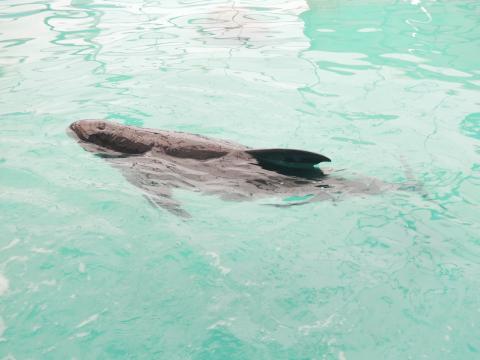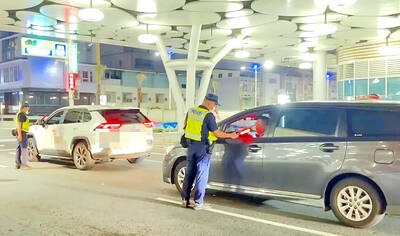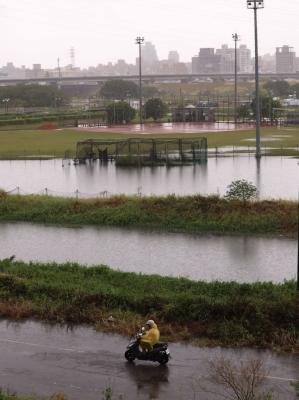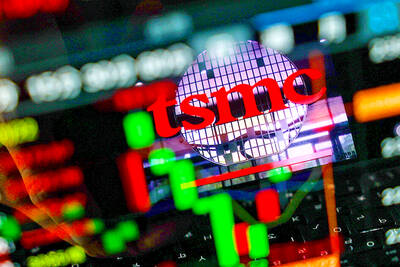A rescued pygmy killer whale that beached on the coast of Pingtung County in April was released back to the sea last week after a record 66 days of rehabilitation involving the efforts of more than 1,000 volunteers.
The release of “A-Gan” (阿淦), a male pygmy killer whale (Feresa attenuata), was another notable success for National Cheng Kung University’s renowned Marine Biology & Cetacean Research Center.
Since 2000, the center has earned an outstanding international reputation after rescuing and rehabilitating 36 stranded dolphins and whales and successfully releasing five of them back into the wild.

Photo: Tsai Wen-chu, Taipei Times
Thanks to these success stories, the center has enhanced Taiwan’s international standing in terms of marine conservation work.
According to the center’s director, Wang Chien-ping (王建平), Taiwan and Japan are the leading countries in Asia in terms of experience and attaining results in scientific research into dolphins and whales.
As for rescuing the marine mammals, Wang said Taiwan is more successful and has put in more effort than Japan.

Photo: Tsai Wen-chu, Taipei Times
“A-Gan’s” pod of pygmy killer whales were found beached on the coast of Chechen Township (車城) on April 14.
After being alerted, volunteers from the Marine Biology & Cetacean Research Center worked through the day to save and help revive six of the whales.
Wang said that of the six whales rescued that day, three died afterward. Two healthy whales were released back to the sea four days later.
The remaining whale was given the name “A-Gan” by volunteers, and was brought back for rehabilitation at the center’s facilities in Sihcao (四草), Greater Tainan.
Wang said that because “A-Gan” had sustained an external injury and had lung and liver problems, he was unable to ingest food or swim.
He recalled it took a lot of effort to save “A-Gan,” as the center needed volunteers around the clock to carefully handle and protect him.
Wang said that when he arrived, the pygmy killer whale was 133kg, but his weight fell to 117kg at one time, before recovering to 122.5kg as he returned to full health.
After the whale began feeding normally — up to 8.5kg of fish food per day — experts judged that “A-Gan” was ready to be released into the wild.
“A-Gan” needed 66 days of rehabilitation, with a total of more than 1,000 volunteers offering round the clock care, as he surpassed the center’s previous record of 64 days of rehabilitation, for a bottled-nose dolphin, last year.
For all its success and international recognition, Wang said that the center is severely under-funded, with an annual working budget of only about NT$1 million (US$33,000) and relies on the hard work and selflessness of volunteers.
Much of the center’s funding comes from Wang himself, and he has even taken out bank loans to sustain its operation.
“We are not only the first in Asia for rescuing dolphins and whales, we are the first in Asia in terms of lack of resources,” one volunteer worker said.
“The average cost of rescuing one marine mammal is NT$600,000. With our annual funding of only NT$1 million, in theory, we can rescue two a year at best,” the volunteer said.
“However, so far this year, our center has rescued nine animals. So you can see expenses far outstrip the available funds,” the volunteer said.
“Besides Taiwan and Japan, in recent years, China has started to get involved in marine mammal rescue,” Wang said.
“They have invested a large amount of money to build up their facilities, and are catching up to Taiwan, but their experience in rescue and rehabilitation still lags far behind us,” he said.
The center has organized donation drives in the past, but with disappointing results. This leads Wang and the center’s volunteers to feel that, “in terms of soliciting public donations, rescuing dolphins and whales fares far worse than saving stray dogs.”
For the overall 66-day effort to rehabilitate “A-Gan”, Wang pointed out that the center had to bear much of the expense.
“It costs money to buy boxed meals for volunteers. It also costs money for the rescue vehicles, for the towing and winching machinery, and for the capelin fish to feed the whale,” he said.
“The vehicle used to haul ‘A-Gan’ to sea cost NT$14,000 to rent, and we still do not know how to pay for it,” Wang said.
The volunteers jokingly pointed to the rescued pygmy killer whale.
“He is the guy who’s eaten up all our center’s money,” they said.

TRAFFIC SAFETY RULES: A positive result in a drug test would result in a two-year license suspension for the driver and vehicle, and a fine of up to NT$180,000 The Ministry of Transportation and Communications is to authorize police to conduct roadside saliva tests by the end of the year to deter people from driving while under the influence of narcotics, it said yesterday. The ministry last month unveiled a draft of amended regulations governing traffic safety rules and penalties, which included provisions empowering police to conduct mandatory saliva tests on drivers. While currently rules authorize police to use oral fluid testing kits for signs of drug use, they do not establish penalties for noncompliance or operating procedures for officers to follow, the ministry said. The proposed changes to the regulations require

Taipei, New Taipei City, Keelung and Taoyuan would issue a decision at 8pm on whether to cancel work and school tomorrow due to forecasted heavy rain, Keelung Mayor Hsieh Kuo-liang (謝國樑) said today. Hsieh told reporters that absent some pressing reason, the four northern cities would announce the decision jointly at 8pm. Keelung is expected to receive between 300mm and 490mm of rain in the period from 2pm today through 2pm tomorrow, Central Weather Administration data showed. Keelung City Government regulations stipulate that school and work can be canceled if rain totals in mountainous or low-elevation areas are forecast to exceed 350mm in

1.4nm WAFERS: While TSMC is gearing up to expand its overseas production, it would also continue to invest in Taiwan, company chairman and CEO C.C. Wei said Taiwan Semiconductor Manufacturing Co (TSMC) has applied for permission to construct a new plant in the Central Taiwan Science Park (中部科學園區), which it would use for the production of new high-speed wafers, the National Science and Technology Council said yesterday. The council, which supervises three major science parks in Taiwan, confirmed that the Central Taiwan Science Park Bureau had received an application on Friday from TSMC, the world’s largest contract chipmaker, to commence work on the new A14 fab. A14 technology, a 1.4 nanometer (nm) process, is designed to drive artificial intelligence transformation by enabling faster computing and greater power

China Airlines Ltd (CAL) yesterday morning joined SkyTeam’s Aviation Challenge for the fourth time, operating a demonstration flight for “net zero carbon emissions” from Taiwan Taoyuan International Airport to Bangkok. The flight used sustainable aviation fuel (SAF) at a ratio of up to 40 percent, the highest proportion CAL has achieved to date, the nation’s largest carrier said. Since April, SAF has become available to Taiwanese international carriers at Taipei International Airport (Songshan airport), Kaohsiung International Airport and Taoyuan airport. In previous challenges, CAL operated “net zero carbon emission flights” to Singapore and Japan. At a ceremony at Taoyuan airport, China Airlines chief sustainability